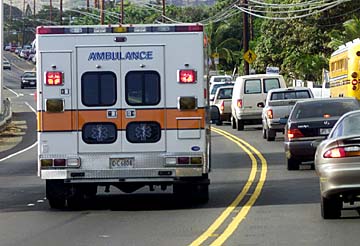
|
Kokua Line
June Watanabe
|

STAR-BULLETIN / 2002
The city has allowed ambulances to respond to low-priority calls without having to turn on lights and sirens for several months. Here, an ambulance bypasses Waianae-bound traffic on Farrington Highway by traveling in the opposite lane.
|
|
City lets ambulance drivers use sirens with discretion
Question: I live in Nuuanu. From time to time, I hear and see ambulances moving makai on Nuuanu late at night with lights flashing and siren wailing, even though there is no traffic to warn. They come into view near the Royal Mausoleum and stay in view through the Nuuanu and Judd intersection. With the cemetery on one side, visibility to and from the side street is good. Why the siren when the lights more than suffice? Are there no rules about blaring sirens late at night when the only outcome is waking the neighbors?
Answer: The state Traffic Code mandates that when an emergency vehicle is responding to an emergency, both lights and sirens are to be utilized, said Patricia Dukes, chief of the city's Emergency Medical Services Division.
However, for the past few months, the city has been allowing ambulances to respond to low-priority calls without having to turn on the lights and sirens.
Dukes happened to be in Salt Lake City last week, being updated on the Medical Priority Dispatching System, which is used by the City and County of Honolulu.
That system determines what types of calls EMS crews respond to in either the "hot" or "cold" mode, she explained.
In a continuing effort to better serve the community, Dukes said EMS took a "first big step" on Feb. 1, by beginning to respond to nonpriority -- meaning not life-threatening -- calls in the "cold" mold.
"Currently EMS responds to about 90 percent of our 911 calls in the 'hot' mode, determined by several factors, mostly which has to do with the patient's chief complaint," Dukes said.
"The other 10 percent of the calls have been deemed non-life-threatening, and the ambulances go in 'cold' -- no lights, no sirens."
This process is a "work in progress," she said, adding, "I believe we can do better" in raising the percentage of "cold" responses.
Dukes said she was gathering information from colleagues from around the country who also are using the Medical Priority Dispatching System.
She acknowledged that flashing lights are effective by themselves at night. Because of that, she said she would look into the possibility of modifying the law to use only the lights at night because "it seems like a good cause to champion."
Dukes said the overall problem with sirens is that they "are not working as they were designed: to get other vehicles on the streets to yield."
Vehicles are being better soundproofed and that fact, combined with "fabulous stereo systems and air conditioning," results in sirens barely being heard by drivers, she said.
Meanwhile, those at home or walking down the street are deafened by the noise. The problem is nationwide.
"The solutions are dynamic: constant review and collaboration from EMS communications experts worldwide," Dukes said. "I don't have a specific solution, and neither do the others. We are always exploring solutions."
Got a question or complaint? Call 529-4773, fax 529-4750, or write to Kokua Line, Honolulu Star-Bulletin, 500 Ala Moana Blvd., No. 7-210, Honolulu 96813. As many as possible will be answered. E-mail to
kokualine@starbulletin.com.
See also: Useful phone numbers

